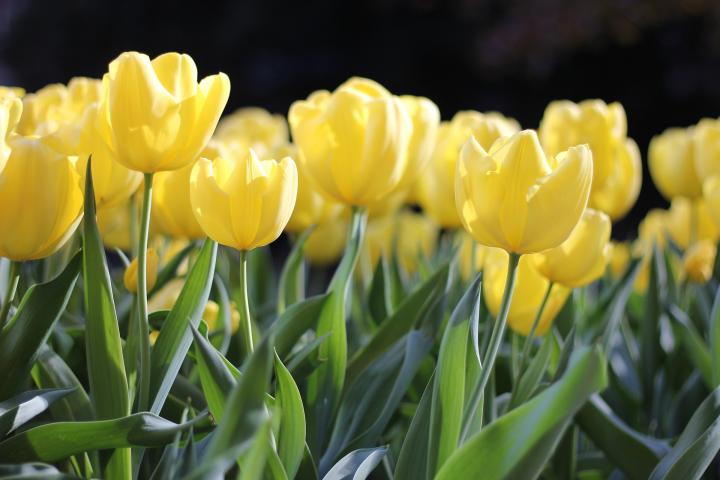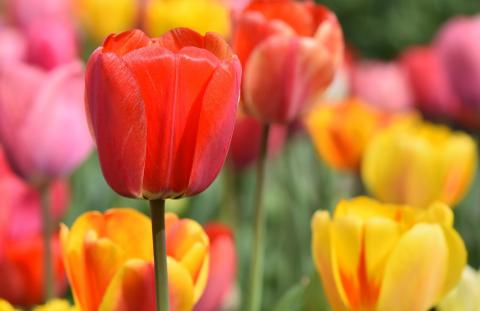Long live the tulip! These brightly colored jewels brighten our days in early spring. We truly look forward to seeing those blue-green leaves start to emerge as the earth awakens from its winter sleep! Here are our tips on how to plant and care for tulips.
About Tulips
Tulips normally begin emerging from the ground in late winter or early spring. If unseasonably mild weather causes premature growth in winter, the danger is not as great as it may seem. Tulips (and daffodils, too) are quite cold tolerant. If freezing winter temperatures return, it may delay growth, however. Snow is actually helpful in this case, as it can insulate the foliage from extreme cold.
Plant in the Fall for Spring Blooms!
Tulip bulbs are planted in the autumn before the ground freezes. By planting varieties with different bloom times, you can have tulips blooming from early to late spring. Some types are good for forcing into bloom indoors and most are excellent for use as cut flowers, too.
Tulip flowers are usually cup-shaped with three petals and three sepals. There’s a tulip for every setting, from small “species” tulips in naturalized woodland areas to larger tulips that fit formal garden plantings from beds to borders. The upright flowers may be single or double, and vary in shape from simple cups, bowls, and goblets to more complex forms. Height ranges from 6 inches to 2 feet. One tulip grows on each stem, with two to six broad leaves per plant.
Are Tulips Annual or Perennial Bulbs?
Although tulips are technically a perennial, many centuries of hybridizing means that the bulb’s ability to come back year after year has weakened. Therefore, many gardeners treat them as annuals, planting new bulbs every autumn. The North American climate and soil can’t replicate the ancient Anatolian and southern Russian conditions of their birth. Gardeners in the western mountainous regions of the U.S. come closest to this climate, and may have more success perennializing their tulips.
When to Plant Tulips
- Plant tulip bulbs in the fall, 6 to 8 weeks before a hard, ground-freezing frost is expected. The bulbs need time to establish themselves. Planting too early leads to disease problems. See local frost dates.
- A good rule of thumb is to plant bulbs when the average nighttime temperatures in your area are in the 40- to 50-degree range.
- In colder northern climates, plant in September or October. In warmer climates, plant bulbs in December (or even later).
- To find the best dates, consult our fall bulb planting chart.
- Nature never intended for bulbs to loll about above ground, so don’t delay planting the bulbs after purchase.
- In southern climates with mild winters, plant bulbs in late November or December. The bulbs will need to be chilled in the refrigerator for about 12 weeks before planting. (Bulb suppliers often offer pre-chilled bulbs for sale, too.)
- If you miss planting your bulbs at the optimal time, don’t wait for spring or next fall. Bulbs aren’t like seeds. Even if you find an unplanted sack of tulips or daffodils in January or February, plant them and take your chances. See more about planting tulips in winter.
Choosing and Preparing a Planting Site
- Tulips prefer a site with full or afternoon sun. In Zones 7 and 8, choose a shady site or one with morning sun only, as tulips don’t like a lot of heat.
- Soil must be well-draining, neutral to slightly acidic, fertile, and dry or sandy. All tulips dislike areas with excessive moisture.
- Tall varieties should be sheltered from strong winds.
- You’ll want to space bulbs 4 to 6 inches apart, so choose a large enough planting site.
- Prepare the garden bed by using a garden fork or tiller to loosen the soil to a depth of 12 to 15 inches, then mix in a 2- to 4-inch layer of compost.
How to Plant Tulips
- Plant bulbs fairly deep—6 to 8 inches deep, or about three times the height of the bulb. Dig a hole deeper than that in order to loosen the soil and allow for drainage. In clay soils, plant 3 to 6 inches deep instead.
- Set the bulb in the hole with the pointy end up. Cover with soil and press soil firmly.
- Water bulbs right after planting. Although they can’t bear wet feet, bulbs need water to trigger growth.
- If you’re planning to raise perennial tulips, feed them a balanced fertilizer when you plant them in the fall. Bulbs are their own complete storage system and contain all of the nutrients they need for one year. Use organic material, compost, or a balanced time-release bulb food.
- To deter mice and moles—if they have been a problem—put holly or any other thorny leaves in the planting holes. Some gardeners use kitty litter or crushed gravel. If ravenous voles and rodents are a real problem, you may need to take stronger measures, such as planting bulbs in buried wire cages.
- Don’t lose hope if you’re planting your tulips later in the season—just follow these tips.

How to Grow Tulips
- If it rains weekly, do not water. However, if there is a dry spell and it does not rain, you should water the bulbs weekly until the ground freezes.
- Rainy summers, irrigation systems, and wet soil are death to tulips. Never deliberately water a bulb bed unless in a drought. Wet soil leads to fungus and disease and can rot bulbs. Add shredded pine bark, sand, or any other rough material to the soil to foster swift drainage.
- Apply compost annually to provide nutrients needed for future blooms.
- In the spring, when leaves emerge, feed your tulip the same bulb food or bone meal which you used at planting time. Water well.
- Deadhead tulips as soon as they go by, but do not remove the leaves!
- Allow the leaves to remain on the plants for about 6 weeks after flowering. The tulips need their foliage to gather energy for next year’s blooms! After the foliage turns yellow and dies back, it can be pruned off.
- Large varieties may need replanting every few years; small types usually multiply and spread on their own.

- Gray mold
- Slugs
- Snails
- Aphids
- Nematodes
- Bulb rot
- Squirrels, rabbits, mice, and voles are especially fond of tulip bulbs.
Tulip flowers may be single, double, ruffled, fringed, or lily-shaped, depending on the variety.
Wild—or “Species”—tulips are small in size, ranging in height from 3 to 8 inches. They are tougher than hybrids. They also bloom in the South and look best when planted as a carpet of color. One of our favorites is ‘Lilac Wonder’.
Triumph hybrids are the classic single, cup-shape tulip that make up the largest grouping of tulip types. Top varieties:
- ‘Cracker tulip’ is a midspring bloomer with purple, pink, and lilac petals.
- ‘Ile de France’ is a midseason bloomer, with its intensely red blooms on stems to 20 inches tall.
- ‘Calgary’ is a midspring bloomer with snowy-white petals and blue-green foliage.
- Though tulips tend be planted as annuals, the Darwin Hybrid tulips are known to act as perennials, blooming for several years.
There are so many beautiful varieties of tulips. Explore catalogs and experiment in your garden!
- Did you know: If you dig up a tulip bulb in late summer, it’s probably not the same bulb you planted last fall. It’s her daughter. Even while the tulip is blossoming, the bulb is dividing for the next generation.
- To get the longest vase life, cut tulip stems diagonally, then wrap the upper two-thirds of the flowers in a funnel of newspaper and stand them in cool water for an hour or two. Then, recut the stems and the tulips will last at least a week.
- In 17th-century Holland, the new tulip was such the rage and fashion that a handful of bulbs was worth about $44,000.
- Red tulips symbolize a declaration of love. Explore more flower meanings here.




